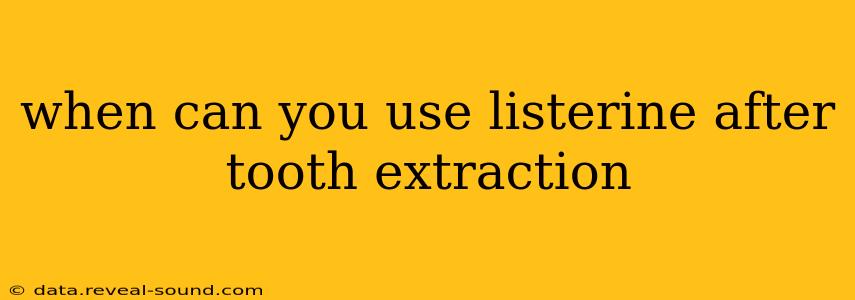Tooth extraction is a common procedure, but proper aftercare is crucial for preventing complications and ensuring a smooth recovery. Many people wonder about using mouthwash, specifically Listerine, after having a tooth pulled. The short answer is: you should generally avoid using Listerine immediately after a tooth extraction. Let's delve deeper into the reasons why and when it might be safe to resume its use.
Why Avoid Listerine Immediately After Tooth Extraction?
The potent ingredients in Listerine, designed to kill bacteria, can also irritate the sensitive extraction site. Immediately after an extraction, a blood clot forms in the socket where the tooth was removed. This clot is essential for healing and preventing a painful, potentially serious condition called dry socket. The alcohol and other active ingredients in Listerine can:
- Dissolve the blood clot: This increases the risk of dry socket, characterized by intense pain, bad breath, and a visible empty socket.
- Cause Irritation and Burning: The extraction site is already inflamed and sensitive. Listerine's strong ingredients can further irritate the area, causing burning and discomfort.
- Slow Down Healing: While Listerine fights bacteria, it can also disrupt the delicate healing process, potentially prolonging recovery time.
When Can You Start Using Listerine Again?
The ideal time to resume using Listerine after a tooth extraction depends on several factors, including the complexity of the extraction and your individual healing process. However, a general guideline is to wait at least 24-48 hours before rinsing with any type of mouthwash, including Listerine.
Even after this waiting period, it's crucial to proceed with caution. Begin with gentle rinsing using a diluted solution—perhaps half-strength Listerine and half water—to minimize irritation.
What Should You Use Instead of Listerine Immediately After Extraction?
For the first 24-48 hours, focus on gentle rinsing with a saltwater solution. Dissolve a half-teaspoon of salt in 8 ounces of warm water and gently swish it around your mouth several times a day. This helps clean the area without disrupting the blood clot or causing irritation. Your dentist or oral surgeon may also recommend a prescription mouthwash for the first few days.
How to Safely Use Listerine After Tooth Extraction?
Once you've waited the recommended time and are cleared by your dentist, here are some tips for using Listerine:
- Dilute: Start with a diluted solution and gradually increase the concentration as tolerated.
- Gentle Rinsing: Avoid forceful swishing or spitting; instead, gently rinse the mouth and then let the mouthwash drain out.
- Observe for Irritation: If you experience any burning, discomfort, or increased bleeding, stop using Listerine immediately and consult your dentist.
- Follow Dentist's Instructions: Always follow your dentist's specific post-operative instructions. They may recommend avoiding mouthwash altogether for a longer period if your case requires it.
What if I Develop Dry Socket?
If you experience intense pain, bad breath, and a visible empty socket after a tooth extraction, you may have developed dry socket. This is a serious complication that requires immediate medical attention. Contact your dentist or oral surgeon immediately if you suspect you have dry socket.
Can I use other mouthwashes after tooth extraction?
The same precautions apply to other mouthwashes, especially those containing alcohol. Always check with your dentist before using any mouthwash after a tooth extraction. They can recommend suitable alternatives that won’t hinder the healing process.
By following these guidelines, you can minimize the risks associated with using Listerine and other mouthwashes after a tooth extraction and promote a healthy recovery. Remember, consulting your dentist or oral surgeon is always the best approach for personalized aftercare advice.
